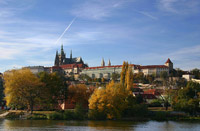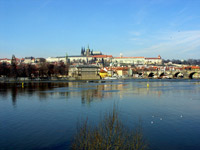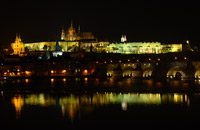Prague Castle (Pražský hrad)
The nearest hotels
- Hotel U Krále Karla (277 m)
- Hotel Best Western Roya … (620 m)
- Hotel U Páva (788 m)
- Hotel Roma (1.01 km)
- Botel Florentina (1.09 km)
The nearest sightseeings
- St. Vitus Cathedral (144 m)
- St. George's Basili … (355 m)
- Golden Lane (380 m)
- St. Nicholas Church (387 m)
- Sternberg Palace (433 m)
Prague Castle (Czech: Pražský hrad) is a castle in Prague where the Kings of Bohemia, Holy Roman Emperors and presidents of Czechoslovakia and the Czech Republic have had their offices. The Bohemian Crown Jewels are kept here.
According to the Guinness Book of World Records, the Prague Castle is the largest coherent castle complex in the world with an area of almost 70000 m², being 570 meters in length and an average of about 130 meters wide.
History
The history of the castle stretches back to the 9th century (870). The first walled building was the Church of the Virgin Mary. The Basilica of Saint George and the Basilica of St. Vitus were founded in the first half of the 10th century. The first convent in Bohemia was founded in the castle, next to the church of St. George. A Romanesque palace was erected here during the 12th century. In the 14th century, under the reign of Charles IV the royal palace was rebuilt in Gothic style and the castle fortifications were strengthened. As a replacement of the previous rotunda and later basilica of St. Vitus, a vast Gothic church was initiated, the construction of which would span almost six centuries. During the Hussite Wars and the following decades the Castle was not inhabited. In 1485, King Ladislaus II Jagello began to rebuild the castle. The massive Vladislav Hall (built by Benedikt Rejt) was added to the Royal Palace. There were also built new defence towers on the northern side of the castle. A large fire in 1541 destroyed large parts of the castle. Under the Habsburgs some new buildings in renaissance style appeared here. Ferdinand I built Belvedere, summer palace for his wife Anne. Rudolph II used Prague Castle as his main residence. He founded the northern wing of the palace, with the Spanish Hall, where his precious artistic collections were exhibited. The Second Prague defenestration in 1618 began the Bohemian Revolt. During the subsequent wars the Castle was damaged and dilapidated. Many works from the collection of Rudolph II were looted by Swedes in 1648, in the course of the Thirty Years' War. The last major rebuilding of the castle was carried out by Queen Maria Theresa in the second half of the 18th century. Ferdinand V, after abdication in 1848, chose Prague Castle as his home.
In 1918 the castle became the seat of the president of the new Czechoslovak Republic. The New Royal Palace and the gardens were renovated by Slovenian architect Jože Plečnik. Renovations continued in 1936 under Plečnik's successor Pavel Janák.
During the Nazi occupation of Czechoslovakia during World War II, Prague Castle became the headquarters of the "Reich Protector of Bohemia and Moravia" Konstantin von Neurath and his deputy, Reinhard Heydrich. It is said that Heydrich placed the Bohemian crown on his head; old legends say that a usurper who places the crown on his head is doomed to die within a year. Less than a year after assuming power, Heydrich was assassinated.
After the liberation of Czechoslovakia, it housed the offices of the communist Czechoslovak government.
After Czechoslovakia split into the Czech Republic and Slovakia, the castle became the seat of the Head of State of the new Czech Republic. Similar to what Masaryk did with Plečnik, president Václav Havel commissioned Bořek Šípek to be the architect of post-communism Prague Castle's necessary improvements in particular of the facelift of the Castle's Gallery of paintings.
Architectural styles of Prague Castle
The Prague Castle has been rebuilt many times over the centuries, so it virtually represents every architectural style of the last millennium. The Prague Castle includes the Gothic St Vitus Cathedral whose interior is a fine example of Romanesque architecture, the Basilica of St. George, a former Benedictine monastery which houses the world's largest collection of 14th century panel painting, and several palaces, gardens and defensive towers. Most of the castle areas are open to tourists. Nowadays, the castle houses several museums, including the National Gallery collection of Bohemian baroque and mannerist art, an exhibition dedicated to Czech history, a Toy Museum and the picture gallery of Prague Castle, based on the collection of Rudolph II. The Summer Shakespeare Festival, the largest and oldest open-air theatre festival of this type in Europe, regularly takes place in the courtyard of the Burgrave Palace.
Churches
- St. Vitus Cathedral (Katedrála svatého Víta, Václava a Vojtěcha)
- St George's Basilica (Bazilika svatého Jiří) and St George's Convent (Klášter svatého Jiří)
- All Saints Church (Chrám Všech svatých)
- Holy Cross Chapel (Kaple svatého Kříže)
- Church of the Virgin Mary
Palaces
- Starý královský palác (Old Royal Palace)
- Letohrádek královny Anny (Belvedere or Royal Summer Palace)
- Lobkovický palác (Lobkowicz Palace, not to be confused with the German embassy in Malá Strana)
- Nový královský palác (New Royal Palace, Czech Republic, not to be confused with the New Royal Palace in Athens)
Halls
- Sloupová síň (Column Hall)
- Španělský sál (Spanish Hall)
- Rudolfova galerie (Rudolph's Gallery)
- Rothmayerův sál (Rothmayer's Hall)
- Vladislav Hall (Vladislavský sál)
Vladislav Hall, in the Prague Castle, is the largest secular space (62m x 16m x 13m) in medieval Prague and belongs to the most complex structural and architectural spaces of the late Middle Ages. Built between 1493-1502 by Benedikt Ried, it replaced a group of 3d floor rooms dating from the 14th century. Underneath, on the 1st floor, is a Romanesque palace and directly below it, on the 2nd floor, is a Gothic addition built under Charles IV in the 14th century. The construction of the complex stone vaulting system, spanning 16m, was one of the most refined engineering feats of the late Middle Ages.
Other Buildings
- Daliborka (Dalibor Tower)
- Prašná věž or Mihulka (Powder Tower or Mihulka)
- Zlatá ulička (Golden Lane)
- Purkrabství (Supreme Burgrave's House)
- Míčovna (Ball Game Hall)
- Jízdárna Pražského hradu (Riding School)
- Staré proboštství (Old Provost Residence)
- New Provost Residence
Gardens
- Královská zahrada (Royal Garden)
- Zahrada Na terase Jízdárny (Riding School Terrace Garden)
- Zahrada Na Baště (The Garden on the Bastion)
- Jižní zahrady (South Gardens)
- Rajská zahrada (Paradise Garden)
- Zahrada Na Valech (Garden on the Ramparts)
- Hartigovská zahrada (The Hartig Garden)
- Jelení příkop (Deer Moat)
Source: wikipedia.org, licence CC-BY-SA-3.0
Photos
Map
Operator
- Phone: +420 261 264 369
- E-mail: info@arcadira.eu
Tourist information
Tourist Information about Prague and Czech republic. History, Culture, Language, Currency, Visa and much more.
List of our Prague hotels
Prague hotels - 3 star
- Botel Albatros
- Botel Florentina
- Botel Racek
- Hotel Ankora
- Hotel Arbes - Mepro
- Hotel Atos
- Hotel Donatello
- Hotel Globus
- Hotel Gloria
- Hotel ILF
- Hotel Legie
- Hotel Old Prague
- Hotel Olsanka
- Hotel Olympik Tristar
- Hotel Victoria
- King George´s House
Prague hotels - 4 star
- Hotel Adria
- Hotel Amigo
- Hotel Arkada
- Hotel Barceló
- Hotel Barceló Old Town
- Hotel Caesar Palace
- Hotel Corinthia Panorama
- Hotel Golf
- Hotel Holiday Inn Congress Centre
- Hotel Louis Leger
- Hotel Majestic Plaza
- Hotel Olympik
- Hotel Pyramida
- Hotel Roma
- Hotel Step
- Hotel U Krále Karla
- Hotel U Páva
- Hotel Yasmin
Prague hotels - 5 star
Contact
- Pragap Tour, s.r.o. (Arcadira)
- Liliová 10
- 110 00, Praha 1
- Česká republika
- Phone: +420 261 264 369
- Fax: +420 244 400 157
- E-mail: info@arcadira.eu
- Facebook: www.facebook.com
- ICO: 25147412
- DIC: CZ25147412
© 2008-2024 Pragap Tour, s r.o. (Arcadira) | All Rights Reserved | Terms & Conditions | Created by Jaroslav Salivar


